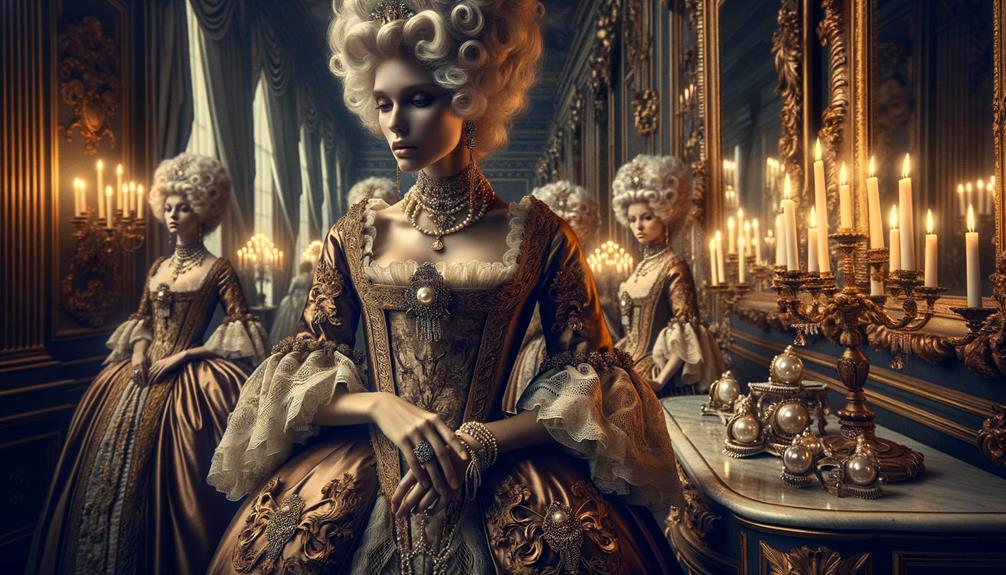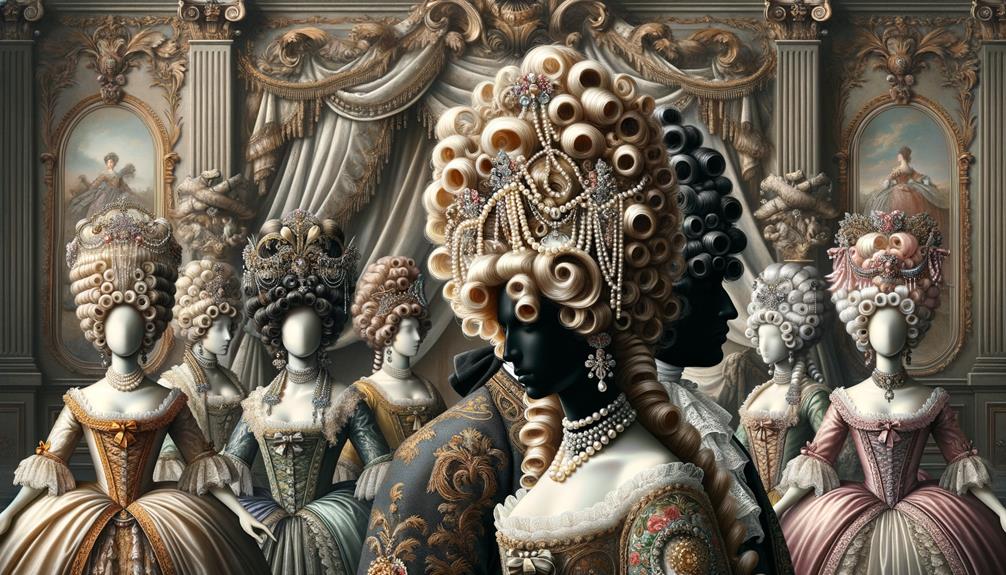Rococo fashion embodies the pinnacle of 18th-century elegance. This style emerged in France and was quickly adopted by the aristocracy, who admired its extravagance. The use of soft pastel hues, such as pink, blue, and cream, added a playful yet refined touch. Luxurious fabrics like silk and velvet, adorned with intricate lace and floral patterns, defined this style. The signature garments included the Robe à la Française and the Chemise à la Reine, known for their ornate details and flowing lines. Influential figures like Madame de Pompadour set the tone for this fashion era. The delicate beauty of Rococo style continues to inspire designers today.
Origins of Rococo Fashion
Rococo fashion emerged in 18th century France, characterized by an emphasis on elegance and extravagance. The French aristocracy enthusiastically adopted this style, seeking to showcase their wealth and status. As a response to the solemnity of earlier eras, Rococo fashion embodied a playful, opulent aesthetic.
During this period, aristocratic fashion was distinguished by soft pastel hues and lavish styles. Delicate fabrics like silk, satin, and velvet were adorned with intricate embellishments such as lace and embroidery. The era's hallmark curved lines and ornate details reflected the aristocracy's desire for luxury and refinement.
Marie Antoinette, a prominent adopter of Rococo fashion, epitomized the style's refined yet extravagant essence. Her influence popularized the delicate aesthetic, making it synonymous with aristocratic taste. However, this fashion style was not just about aesthetics; it also highlighted the class divisions between the aristocracy and commoners.
The tumultuous relationship between the classes was mirrored in the evolution of Rococo fashion. As the style developed, it reflected the shifting social dynamics of 18th-century France. The extravagant styles of the era ultimately contributed to the broader narrative of the time, revealing underlying social tensions.
Key Characteristics
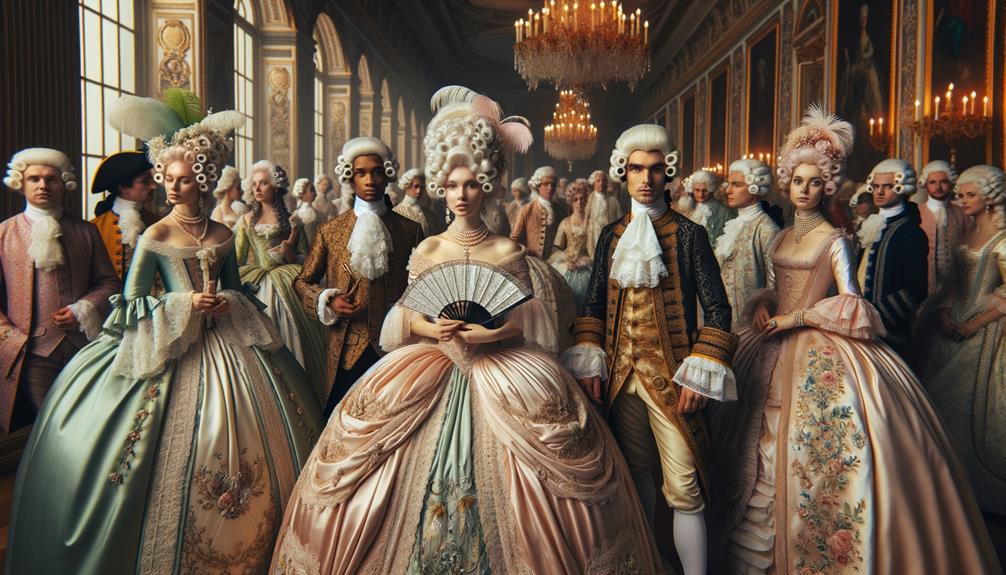
When I think of Rococo fashion, I envision intricate details and a soft, romantic color palette. The ornate lace, delicate ribbons, and whimsical floral patterns evoke a sense of playful sophistication. Pastel hues of pink, blue, and cream add to the charming, airy feel.
Ornate Decorative Elements
In the extravagant world of Rococo fashion, ornate decorative elements like lace and silk flowers define the era's aesthetic. Delicate lace, intricate ruffles, and cascading ribbons create a playful, flirtatious look. From pastel shades to elaborate detailing, everything exudes a sense of elegance and whimsy.
Rococo attire is a visual feast, where each piece of clothing tells a story through its embellishments. Silk flowers adorn gowns, adding a touch of nature's beauty, while lace trims provide a whisper of sophistication. Ruffles and ribbons, often in soft pastel hues, contribute to the overall frivolity and light-hearted charm. Every detail is meticulously crafted, capturing the era's carefree spirit.
The key elements of Rococo fashion include:
Lace – Delicate trims and inserts that add sophistication
Ruffles – Layered frills on sleeves and hems that create a playful elegance
Ribbons – Decorative ties and bows that add a touch of whimsy
Silk Flowers – Floral adornments that bring a touch of nature's beauty
Pastel Shades – Soft, light color palette that creates a frivolous look
Through its ornate decorative elements, Rococo fashion captures an era defined by its pursuit of beauty and grace.
Pastel Color Palette
Soft pastel hues defined the elegance and playfulness of the era's fashion. These colors, like pale pink, sky blue, lilac, and mint green, embodied a delicate, feminine charm. In the Rococo style, pastel colors weren't just a choice; they were a statement of refinement and poise. When combined with luxurious fabrics like silk, satin, and velvet, they created garments that were both opulent and sophisticated.
The pastel palette added a touch of whimsy to the Rococo aesthetic. It wasn't just about lightness; it was about conveying a sense of carefree elegance. Each shade brought an element of charm, making the wearer appear graceful and poised. The delicate tones softened the overall look, ensuring that even the most elaborate designs maintained a sense of refinement.
In Rococo fashion, these pastel colors were more than just visually appealing; they captured the essence of the era. The luxurious textures of the fabrics combined with these soft hues created a harmonious balance of playful sophistication. This blend of whimsy and elegance encapsulated the spirit of the time, making each garment a work of art that was both innovative and timeless.
Influential Designers
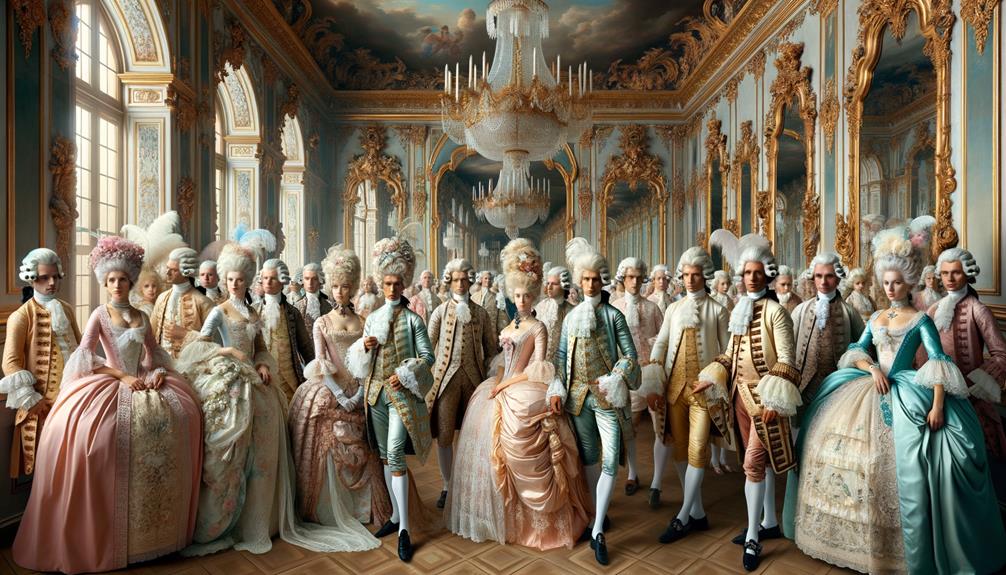
Madame de Pompadour's exquisite taste in fashion set the tone for Rococo style. Her love for luxurious fabrics and intricate designs influenced the courts of Europe, making her a paragon of elegance.
Rose Bertin, known as the Minister of Fashion, built upon these inspirations. Her innovative designs captivated the elite, showcasing creativity in every stitch. Bertin's work epitomized sophistication, pushing the boundaries of what fashion could achieve.
Thomas Gainsborough's artistic portraits played a significant role in immortalizing the Rococo style. His elegant clothing renditions captured the essence of the era's grace and extravagance, making his paintings more than just art.
Marie-Antoine Carême introduced the tailcoat, revolutionizing menswear. His designs were a departure from the norm, yet they became the new standard.
Thérésa Tallien's high-waisted gowns marked another evolution in fashion. Her influence was unmistakable, leaving a lasting impact on the trajectory of fashion.
Iconic Garments
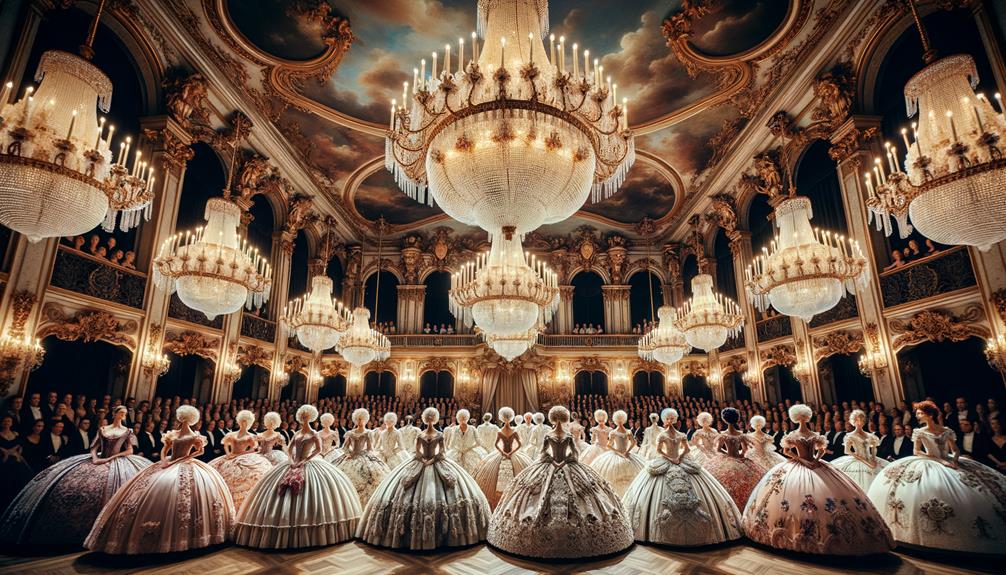
Rococo fashion was renowned for its exquisite garments, each piece a testament to the era's intricate elegance. The Robe à la Française, characterized by its fitted bodice and flowing back pleats, embodied opulent grandeur. In contrast, the Robe à l'Anglaise offered a simpler approach with its high waistline and smooth skirt, providing an alternative to the more extravagant French styles.
The Watteau gown, adorned with pleats at the back, formed a graceful train, perfect for formal occasions. This garment was a staple in the wardrobes of those who appreciated Rococo's delicate artistry. Meanwhile, Mantua dresses, featuring stiff bodices and open front skirts, showcased the era's penchant for extravagant fashion.
Marie Antoinette popularized the Chemise à la Reine, a loose-fitting dress symbolizing a shift towards neoclassical styles. This garment's simplicity stood in stark contrast to the more structured and ornate dresses of the time.
Here's a quick comparison of these iconic garments:
| Garment | Key Features |
|---|---|
| Robe à la Française | Fitted bodice, flowing back pleats |
| Robe à l'Anglaise | High waistline, smooth skirt |
| Watteau gown | Pleats at back, graceful train |
| Mantua dresses | Stiff bodice, open front skirt |
Each piece, a reflection of Rococo's innovative spirit, continues to inspire fashion today.
Fabrics and Materials
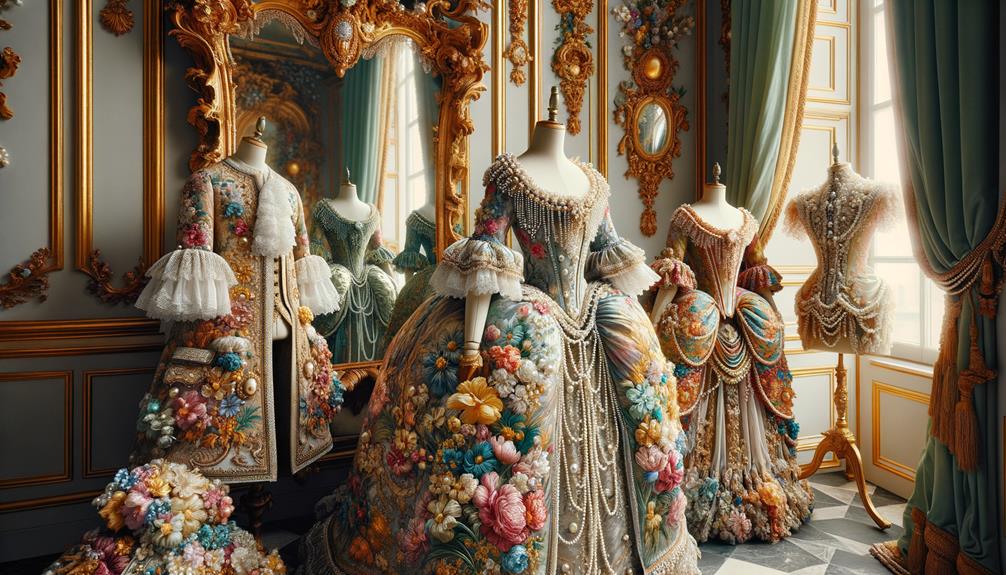
Luxurious fabrics and meticulous materials were the cornerstone of Rococo fashion's elegance. Silk, satin, and velvet provided a rich foundation, feeling as extravagant as they looked. Delicate lace adorned with intricate embroidery added layers of sophistication, while lavish embellishments like silk flowers and ruffles offered a touch of whimsical luxury.
Pastel colors dominated, enhancing the rich textures of these fabrics. The subtle hues brought out the intricate details in the lace and embroidery, creating a harmonious blend of understated elegance and grandeur. Brocade, with its elaborate patterns and deep textures, was a favored choice for those seeking to make a bold, yet refined, statement.
Every piece was a testament to the skill and artistry of the craftsmen. The interplay of rich textures and opulent materials created garments that were not just clothing but works of art. In Rococo fashion, the fabric was as important as the design, each element contributing to an overall sense of elegance and innovation. The meticulous attention to detail in these materials set Rococo fashion apart, creating a legacy of timeless beauty.
Rococo Color Palette
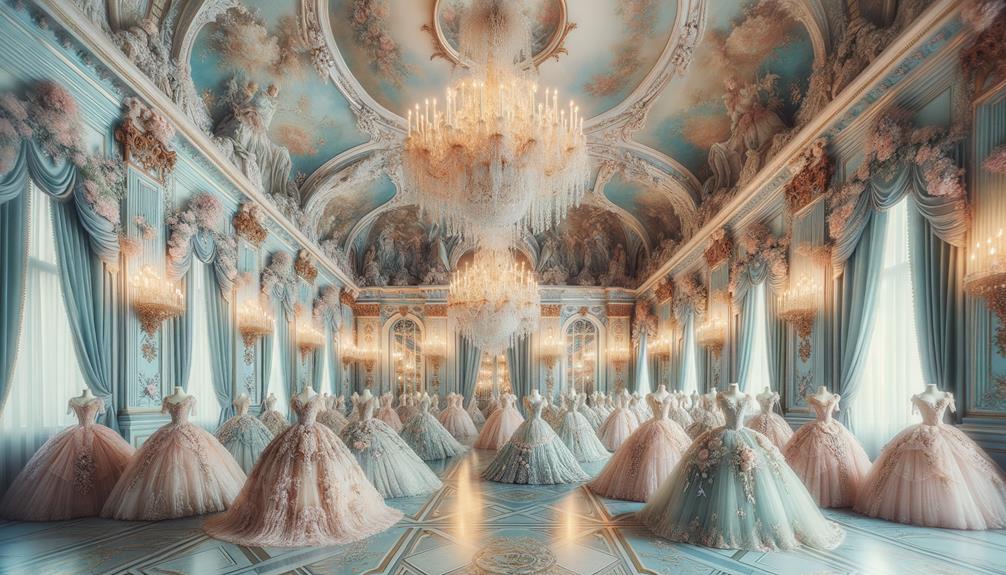
The Rococo era's fashion was defined by soft pastel shades, including pale pink, sky blue, lilac, and mint green. These delicate hues embodied the era's emphasis on elegance and refinement. The Rococo color palette, with its gentle tones, perfectly complemented the opulent fabrics and intricate embellishments of the period.
I noticed that the pastel shades not only softened the overall look but also enhanced the romantic aesthetic cherished in Rococo fashion. Each color, from the softest pink to the lightest mint green, added a layer of sophistication and grace. The palette's light, airy quality conveyed a sense of lightheartedness and charm, contrasting with the darker, more somber hues of previous eras.
The delicate colors harmonized beautifully with the luxurious materials and elaborate designs. Intricate lace, ornate embroidery, and fine silk seemed even more exquisite when rendered in these gentle shades. The Rococo color palette didn't just dress the body; it adorned it with an ethereal, almost otherworldly beauty. This thoughtful selection of colors spoke volumes about the era's dedication to creating a visual language of elegance and refinement.
Lasting Legacy
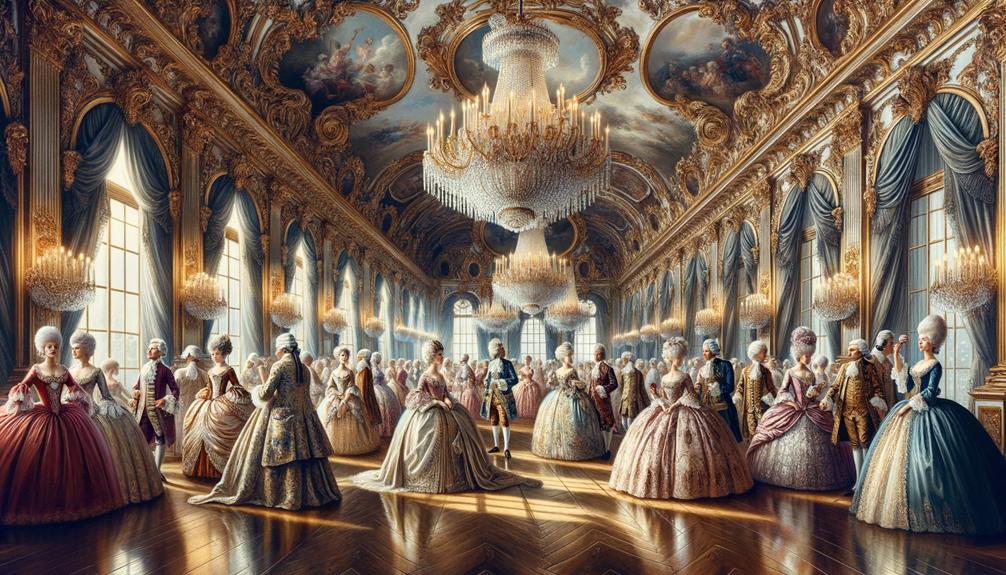
Rococo's enduring elegance continues to inspire modern design, from high-fashion runways to lavish interior spaces. The ornate style's cultural significance persists, epitomizing refined sophistication and opulence.
Influence on Modern Design
Modern design owes a debt of gratitude to the intricate details and opulent fabrics of Rococo fashion. The delicate patterns and lavish embellishments, such as lace and embroidery, have found their way into contemporary fashion collections. Designers today draw inspiration from these intricate patterns, creating pieces that echo the sophistication and femininity of the Rococo era.
The soft, pastel color palette of Rococo clothing continues to influence modern design. These hues evoke a sense of romance and luxury, adding a timeless quality to today's fashion. Flowing silhouettes, reminiscent of Rococo's fitted bodices and flowing skirts, maintain their appeal in modern couture. These elements infuse an air of elegance and grace into contemporary styles.
Lavish embellishments are another legacy that modern design has adopted. Intricate beadwork, delicate lace, and elaborate embroidery add depth and dimension to fabric, reflecting Rococo's attention to detail. Today's high fashion showcases these elements, underscoring the enduring allure of Rococo's opulent fabrics.
In observing modern fashion, it's clear that the legacy of Rococo fashion endures. Its influence is seen in the continued emphasis on sophistication, intricate embellishments, and flowing silhouettes, all adding a touch of timeless elegance.
Continuing Cultural Impact
The timeless allure of Rococo fashion continues to inspire modern couture, with its intricate details and lavish embellishments leaving an unmistakable mark on contemporary design. Modern haute couture often pays homage to the Rococo tradition, incorporating delicate details and intricate embroidery into its designs.
In today's formal wear, we see nods to Rococo's signature pastel colors and floral prints, which evoke a sense of refined sophistication. Designers continue to draw inspiration from Rococo's emphasis on grace and luxury, creating pieces that echo the era's splendor.
Luxurious fabrics like silk, satin, and velvet remain staples in modern fashion, while flowing silhouettes and fitted bodices continue to be popular, reflecting Rococo's enduring elegance. Intricate embroidery and floral prints pay tribute to the era's exceptional craftsmanship. Pastel colors provide a soft, yet striking palette that defines elegance.
Each piece crafted today carries a subtle nod to Rococo's grandeur, a testament to the era's lasting cultural influence. The dedication to refinement and opulence that defined Rococo continues to set a high standard for timeless elegance in fashion, inspiring innovation and creativity.
Frequently Asked Questions
Is Rococo Elegant?
Rococo is the epitome of elegance, with its delicate lace, soft pastel hues, and intricate designs that evoke a sense of refinement. It's a style that exudes sophistication, wrapped in a timeless charm that never goes out of fashion.
What Are the Characteristics of Rococo Fashion?
Rococo fashion is characterized by its elegance, refinement, and extravagance. Delicate pastel hues, intricate lace, and ornate ruffles and ribbons adorn the clothing, while silk flowers add a touch of whimsy. This playful, flirtatious style reflects an aristocracy preoccupied with personal pleasure and entangled with political events.
What Were the Beauty Standards in Rococo?
In the Rococo era, beauty standards were all about subtlety and restraint. A pale complexion was highly prized, accompanied by rosy cheeks that hinted at good health. Personal hygiene was also crucial, with regular baths and fresh linens being the norm. Hairstyles became more elaborate, but makeup was kept natural and understated, allowing the wearer's natural beauty to shine through.
What Was the Rococo Style Known For?
Rococo was marked by its lavishness and refinement, boasting intricate details and sumptuous fabrics. I see it as a playful shift away from solemnity, showcasing the aristocracy's pursuit of refined, frivolous beauty.



